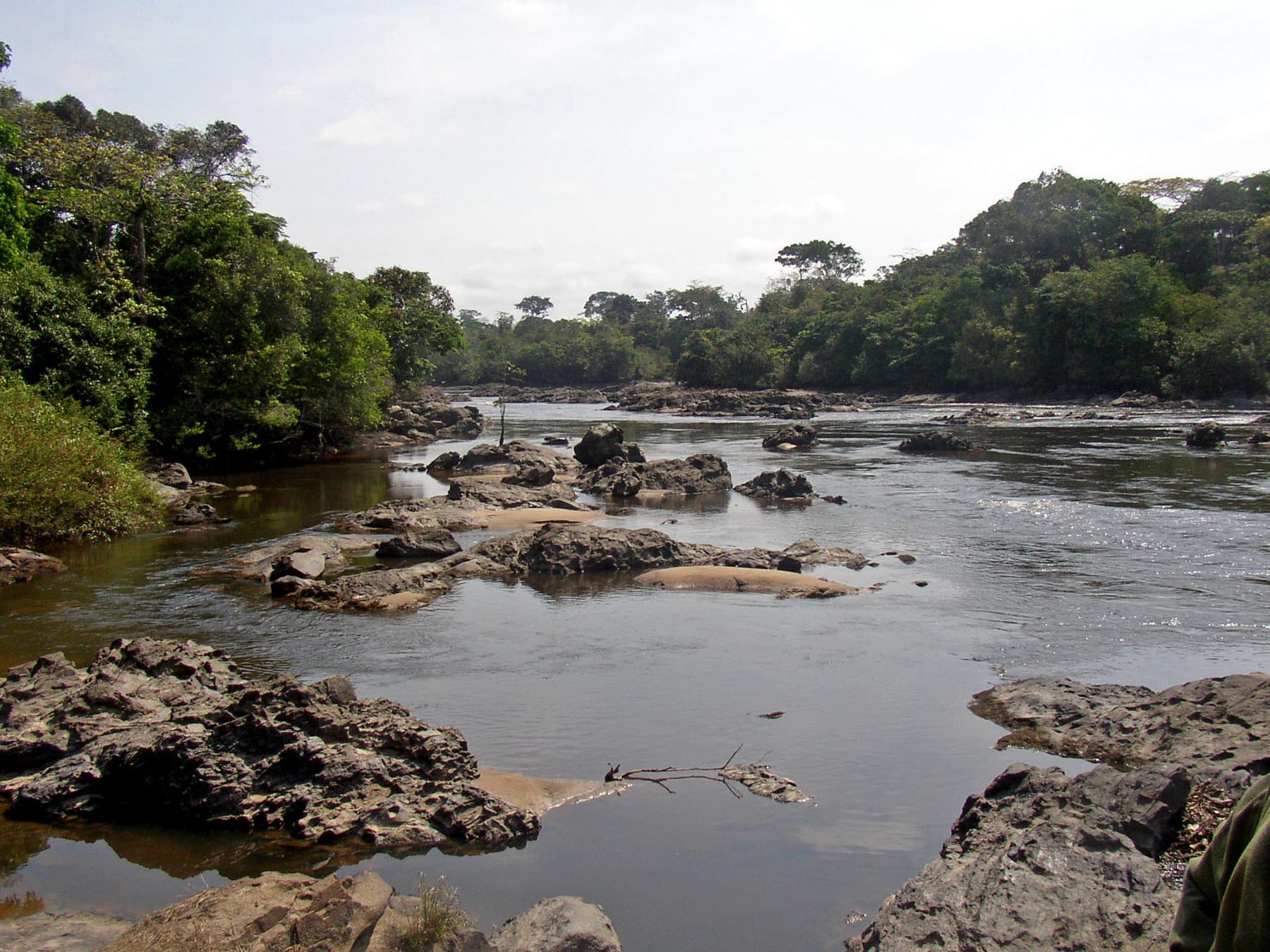|
Northern Congolian Forest–savanna Mosaic
The Northern Congolian forest–savanna mosaic is a forest and savanna ecoregion of central Africa. It extends east and west across central Africa, covering parts of Cameroon, Central African Republic, Democratic Republic of the Congo, South Sudan, and Uganda. It is part of the belt of transitional forest-savanna mosaic that lie between Africa's moist equatorial Guineo-Congolian forests and the tropical dry forests, savannas, and grasslands to the north and south.Burgess, Neil, Jennifer D'Amico Hales, Emma Underwood, et al. (2004). "Terrestrial Ecoregions of Africa and Madagascar: A Conservation Assessment". World Wildlife Fund. Island Press, 2004, pp. 294-296. Geography The Northern Congolian forest–savanna mosaic lies between the equatorial Congolian forests to the south and the drier East Sudanian savanna to the north. It extends from the Cameroon Highlands in the west, across central Cameroon and the southern Central African Republic to southwestern South Sudan and northeast ... [...More Info...] [...Related Items...] OR: [Wikipedia] [Google] [Baidu] |
Garamba National Park
Garamba National Park is a nearly national park in north-eastern Democratic Republic of the Congo. It is among Africa's oldest parks, and was designated a World Heritage Site by UNESCO in 1980 for its protection of critical habitat for northern white rhinoceroses, elephants, hippopotamuses, and giraffes. Garamba has been managed by African Parks in partnership with the Institut Congolais pour la Conservation de la Nature (ICCN), since 2005. Overview Garamba National Park was established in 1938 and covers an area of a in northeastern Democratic Republic of the Congo. It is bounded by Gangala-na-Bodio Hunting Reserve on the west, south, and east, and borders South Sudan on the north and northeast. It is part of the Sudano– Guinean savanna zone. The park is one of Africa's oldest protected areas. It lies in the transition zone between two centres of endemism: Guinea-Congolian and Guinean-Sudanese savanna. These two biogeographic zones support a variety of wildlife, which hav ... [...More Info...] [...Related Items...] OR: [Wikipedia] [Google] [Baidu] |
Guineo-Congolian Forests
The Guineo-Congolian region is a biogeographical region in Africa straddling the Equator and stretching from the Atlantic Ocean through the Congo Basin to the Congo / Nile divide in Rwanda and Burundi. Formerly, this region was largely covered in rain forest, on both well-drained sites and in swamp forests, but little undisturbed primary forest now remains, having been replaced in many areas by savanna and secondary-growth forest. Description The Guineo-Congolian region is a tropical, lowland rain forest area, typified by the forests of the Congo Basin. The terrain is generally under and the annual rainfall is typically in the range . The forest is tall with a dense canopy, or more above the ground, with emergent trees up to tall, and with several layers. The constituent trees are mostly evergreen or semi-evergreen, with a scattering of deciduous species. In the wetter areas, the trees may be clad with numerous epiphytes, but these are less common in drier areas. Large trees ty ... [...More Info...] [...Related Items...] OR: [Wikipedia] [Google] [Baidu] |
Parinari Congensis
''Parinari'' is a genus of plant in the family Chrysobalanaceae. Species of genus ''Parinari'' are found in Subsaharan Africa from Senegal to Sudan and Kenya and south to Namibia and Natal; in Eastern Madagascar; from Indochina through Indonesia, New Guinea, northern Queensland, and the southwest Pacific; and in Central and South America from Costa Rica to Trinidad and southern Brazil. The oldest fossils of ''Parinari'' fruits are from the early Miocene of Ethiopia, Panama, and Colombia. The genus is closely related to ''Neocarya''. ''Parinari'' can be distinguished from other genera in Chrysobalanaceae by the following characteristics: * zygomorphic floral symmetry * 6-10 unilaterally-attached stamens per flower * ovary at side or mouth of receptacle-tube * leaf lower surface lanate and with hair-filled stomatal cavities and parallel secondaries closely spaced * pair of glands on leaf petiole * large, woody fruits Species ''The Plant List'' recognises 42 accepted species ... [...More Info...] [...Related Items...] OR: [Wikipedia] [Google] [Baidu] |
Diospyros Elliotii
''Diospyros'' is a genus of over 700 species of deciduous and evergreen trees and shrubs. The majority are native to the tropics, with only a few species extending into temperate regions. Individual species valued for their hard, heavy, dark timber, are commonly known as ebony trees, while others are valued for their fruit and known as persimmon trees. Some are useful as ornamentals and many are of local ecological importance. Species of this genus are generally dioecious, with separate male and female plants. Taxonomy and etymology The generic name ''Diospyros'' comes from a Latin name for the Caucasian persimmon ('' D. lotus''), derived from the Greek διόσπυρος : dióspyros, from ''diós'' () and ''pyrós'' (). The Greek name literally means "Zeus's wheat" but more generally intends "divine food" or "divine fruit". Muddled translations sometimes give rise to curious and inappropriate interpretations such as "God's pear" and "Jove's fire". The genus is a large one and ... [...More Info...] [...Related Items...] OR: [Wikipedia] [Google] [Baidu] |
Cynometra Vogelii
''Cynometra'' is genus of tropical forest trees with a pantropical distribution. It is particularly important as a forest component in west Africa and the neotropics. ''Cynometra alexandri'' (muhimbi) is a familiar timber tree of central and east Africa. The genus is a member of the subfamily Detarioideae. It has been suggested that ''Cynometra'' is polyphyletic and is in need of revision. In 2019, beside description of 4 new species (i.e. ''Cynometra cerebriformis'', '' C. dwyeri'', '' C. steyermarkii'' and '' C. tumbesiana''), suggested that the species formerly recognized as '' Maniltoa'' should be included in this genus and some of the mainland tropical African species (those with asterisk in the list below) excluded from this genus because of their jointed pedicels and dehiscent fruits (he has not yet published any new combination for them, though). Species The list below is based on Plants of the World OnlinePOWO (2019). "Plants of the World Online. Facilitated by the Roya ... [...More Info...] [...Related Items...] OR: [Wikipedia] [Google] [Baidu] |
Cola Laurifolia
Cola is a carbonated soft drink flavored with vanilla, cinnamon, citrus oils and other flavorings. Cola became popular worldwide after the American pharmacist John Stith Pemberton invented Coca-Cola, a trademarked brand, in 1886, which was imitated by other manufacturers. Most colas contain caffeine originally from the kola nut, leading to the drink's name, though other sources have since been used. The Pemberton cola drink also contained a coca plant extract. His non-alcoholic recipe was inspired by the coca wine of pharmacist Angelo Mariani, created in 1863. Most modern colas have a dark caramel color, and are sweetened with sugar and/or high-fructose corn syrup. They come in numerous different brands. with Coca-Cola and Pepsi being among the most popular. These two companies have been competing since the 1890s, a rivalry that has intensified since the 1980s. Flavorings The primary modern flavorings in a cola drink are citrus oils (from orange, lime, and lemon peels), ci ... [...More Info...] [...Related Items...] OR: [Wikipedia] [Google] [Baidu] |
Berlinia Grandiflora
''Berlinia grandiflora'' is a small to medium sized tree found in the West and West Central African region along riparian habitats or gallery forests habitat types. Description ''Berlinia grandiflora'' is a small to medium sized tree that ranges from 2–20 m tall but can grow up to 30 m. Leaves are paripinnately compound arranged in 3–4 pairs of leaflets per pinnae, the petiole is 20-42 mm long and petiolules is 5–9 mm long; terminal leaflets are 7–22 cm long and 3.0–11.5 cm wide, the abaxial surface is glabrous to sparsely pubescent, leaf-blade is oblong to obovate in outline. Inflorescence is a branched panicle, it has scented green or white colored flowers, commonly with a single petal that is white and 3.5–6.5 cm long, the bracteoles tend to be between 23–32 mm long and 11–20 mm wide; has up to 10 stamens. Fruit is a flattened brown pod. Distribution The species is found in Guinea eastwards to the Democratic Republic of the Congo The Democratic Republ ... [...More Info...] [...Related Items...] OR: [Wikipedia] [Google] [Baidu] |
Tropical Savanna Climate
Tropical savanna climate or tropical wet and dry climate is a tropical climate sub-type that corresponds to the Köppen climate classification categories ''Aw'' (for a dry winter) and ''As'' (for a dry summer). The driest month has less than of precipitation and also less than 100-\left (\frac \right)mm of precipitation. This latter fact is in a direct contrast to a tropical monsoon climate, whose driest month sees less than of precipitation but has ''more'' than 100-\left (\frac \right) of precipitation. In essence, a tropical savanna climate tends to either see less overall rainfall than a tropical monsoon climate or have more pronounced dry season(s). In tropical savanna climates, the dry season can become severe, and often drought conditions prevail during the course of the year. Tropical savanna climates often feature tree-studded grasslands due to its dryness, rather than thick jungle. It is this widespread occurrence of tall, coarse grass (called savanna) which has led to ... [...More Info...] [...Related Items...] OR: [Wikipedia] [Google] [Baidu] |
Nile River
The Nile, , Bohairic , lg, Kiira , Nobiin: Áman Dawū is a major north-flowing river in northeastern Africa. It flows into the Mediterranean Sea. The Nile is the longest river in Africa and has historically been considered the longest river in the world, though this has been contested by research suggesting that the Amazon River is slightly longer.Amazon Longer Than Nile River, Scientists Say Of the world's major rivers, the Nile is one of the smallest, as measured by annual flow in cubic metres of water. About long, its covers eleven countries: the |
Congo River
The Congo River ( kg, Nzâdi Kôngo, french: Fleuve Congo, pt, Rio Congo), formerly also known as the Zaire River, is the second longest river in Africa, shorter only than the Nile, as well as the second largest river in the world by discharge volume, following only the Amazon. It is also the world's deepest recorded river, with measured depths around . The Congo- Lualaba- Chambeshi River system has an overall length of , which makes it the world's ninth- longest river. The Chambeshi is a tributary of the Lualaba River, and ''Lualaba'' is the name of the Congo River upstream of Boyoma Falls, extending for . Measured along with the Lualaba, the main tributary, the Congo River has a total length of . It is the only major river to cross the Equator twice. The Congo Basin has a total area of about , or 13% of the entire African landmass. Name The name ''Congo/Kongo'' originates from the Kingdom of Kongo once located on the southern bank of the river. The kingdom in turn was name ... [...More Info...] [...Related Items...] OR: [Wikipedia] [Google] [Baidu] |
Precambrian
The Precambrian (or Pre-Cambrian, sometimes abbreviated pꞒ, or Cryptozoic) is the earliest part of Earth's history, set before the current Phanerozoic Eon. The Precambrian is so named because it preceded the Cambrian, the first period of the Phanerozoic Eon, which is named after Cambria, the Latinised name for Wales, where rocks from this age were first studied. The Precambrian accounts for 88% of the Earth's geologic time. The Precambrian is an informal unit of geologic time, subdivided into three eons ( Hadean, Archean, Proterozoic) of the geologic time scale. It spans from the formation of Earth about 4.6 billion years ago ( Ga) to the beginning of the Cambrian Period, about million years ago ( Ma), when hard-shelled creatures first appeared in abundance. Overview Relatively little is known about the Precambrian, despite it making up roughly seven-eighths of the Earth's history, and what is known has largely been discovered from the 1960s onwards. The Precambrian fossil ... [...More Info...] [...Related Items...] OR: [Wikipedia] [Google] [Baidu] |







